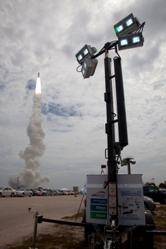Fuel Cell Mobile Lighting System Featured at Space Shuttle Atlantis Launch
 Fuel cells are used in the space shuttle as one component of the electrical power system, so perhaps it was appropriate that a hydrogen fuel cell-powered mobile lighting system could be seen on the grounds of the Kennedy Space Center as the Space Shuttle Atlantis launched into space last week, the 135th and final mission for the NASA Space Shuttle Program.
Fuel cells are used in the space shuttle as one component of the electrical power system, so perhaps it was appropriate that a hydrogen fuel cell-powered mobile lighting system could be seen on the grounds of the Kennedy Space Center as the Space Shuttle Atlantis launched into space last week, the 135th and final mission for the NASA Space Shuttle Program.
The lighting system was deployed to the site of the final space shuttle launch and observed by visitors, shuttle astronauts and members of the international media.
The unit provided lighting in the international press area, and its auxiliary power was used to recharge the camera battery packs for a number of photographers at the event. The NASA deployment was the latest in a series of high-profile test sites where the lighting system has been used.
The hydrogen fuel cell-powered mobile lighting system is a clean, quiet and efficient alternative to traditional technologies commonly powered by diesel fueled generators. The system features a fuel cell running on pure hydrogen, resulting in zero-emission electrical power. The fuel cell produces electricity for an advanced, power-saving Light Emitting PlasmaTM (LEP) lighting system and additional auxiliary power up to 2.5 kW, which allows additional equipment (such as power tools, public address systems or security metal detectors) to be powered by the unit at the same time the system is providing illumination.
Current mobile lighting typically uses diesel-fueled generators that produce greenhouse gases such as carbon dioxide nitrogen oxides, which produce pollutants and create smog, and soot, making them environmentally objectionable. In addition, diesel units are noisy and can create a safety hazard when construction personnel are distracted and cannot hear oncoming traffic.
Sandia researchers estimate that replacing a diesel lighting system with one powered by a hydrogen fuel cell would offset 900 gallons of diesel fuel per year and completely eliminate soot, nitrogen-oxide and carbon-dioxide emissions. This lack of emissions would also make it safe to use the system indoors, in contrast with current diesel technology.
“This hydrogen fuel cell-powered mobile lighting system has the very real potential to drastically reduce dependence on diesel-fueled mobile lighting across the United States and abroad,” said Lennie Klebanoff, the project lead.
The prototype system has been tested in a variety of environments and has primarily focused on the entertainment, transportation and airport sectors. In addition to NASA (which also used the system during the Space Shuttle Endeavor launch) customers who have provided test sites include the California Department of Transportation, the 2010 Academy Awards ceremony, the 2011 Golden Globe Awards, the 2011 Screen Actors Guild Awards and the 2011 Grammy Awards. Boeing, the San Francisco International Airport and Paramount Pictures will soon be deploying units as well.
In addition to the DOE’s sponsorship and Sandia’s design and technical management role, the industry partners on the project include Boeing, Multiquip Inc., Altergy Systems, Luxim Corp., Lumenworks Inc., Stray Light Optical Technologies, Golden State Energy and Ovonic Hydrogen Solutions. The California Fuel Cell Partnership has provided support on hydrogen fuel for several deployments. Multiquip is implementing a manufacturing and commercialization plan for the system.